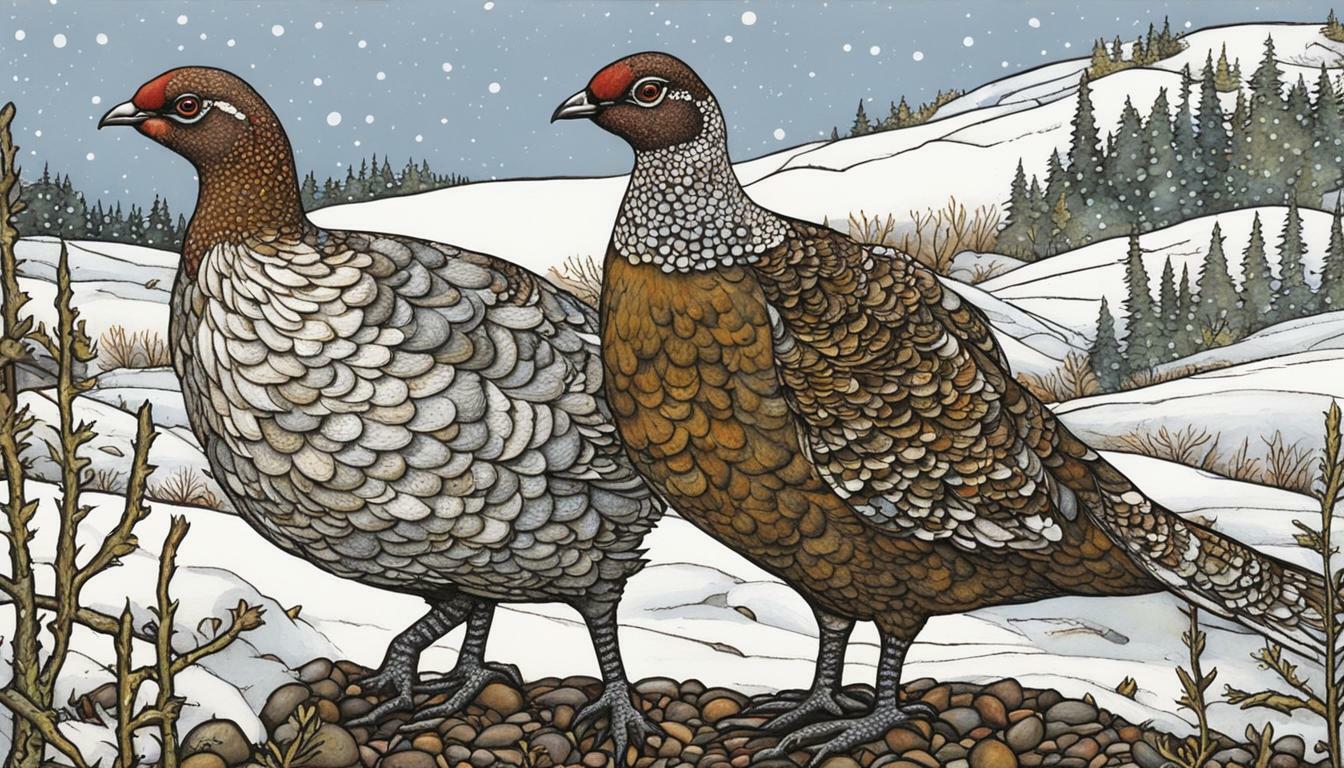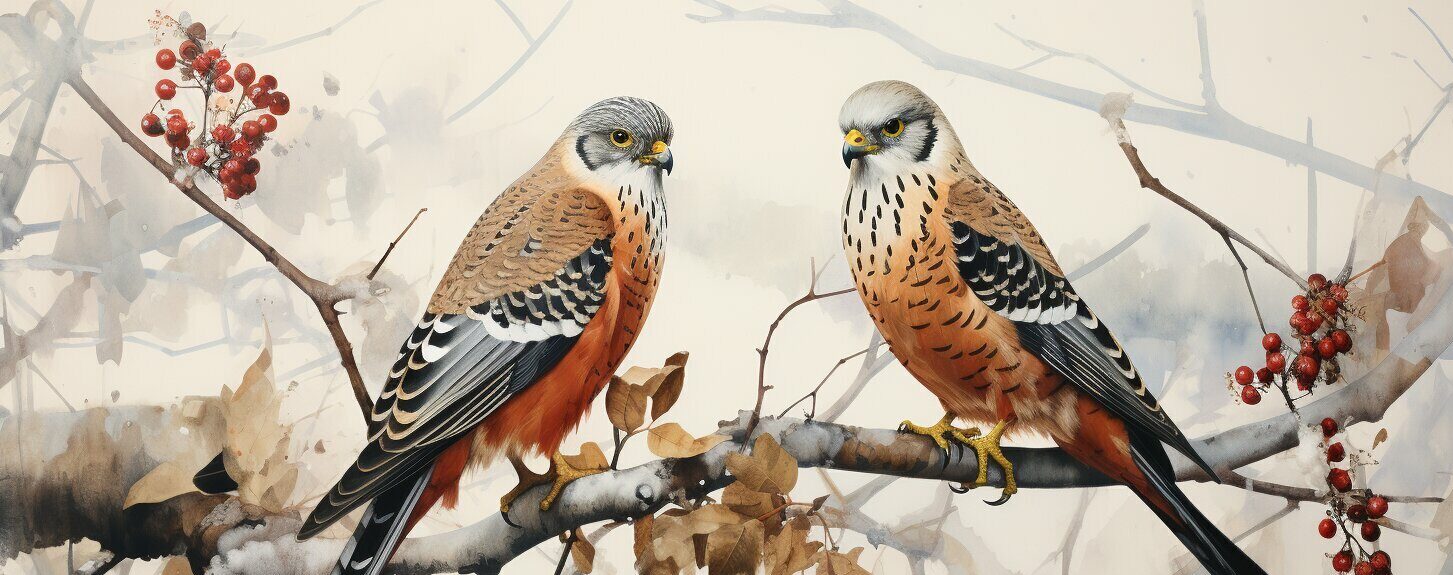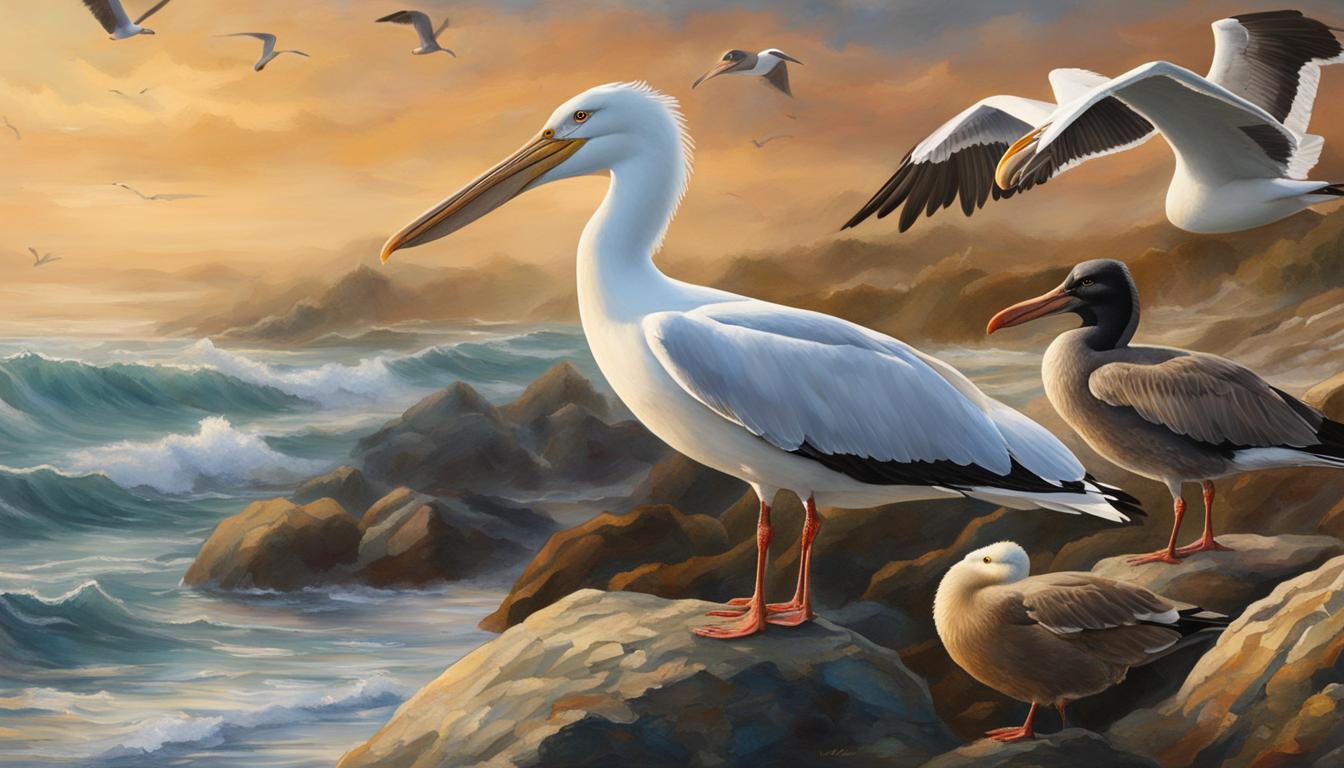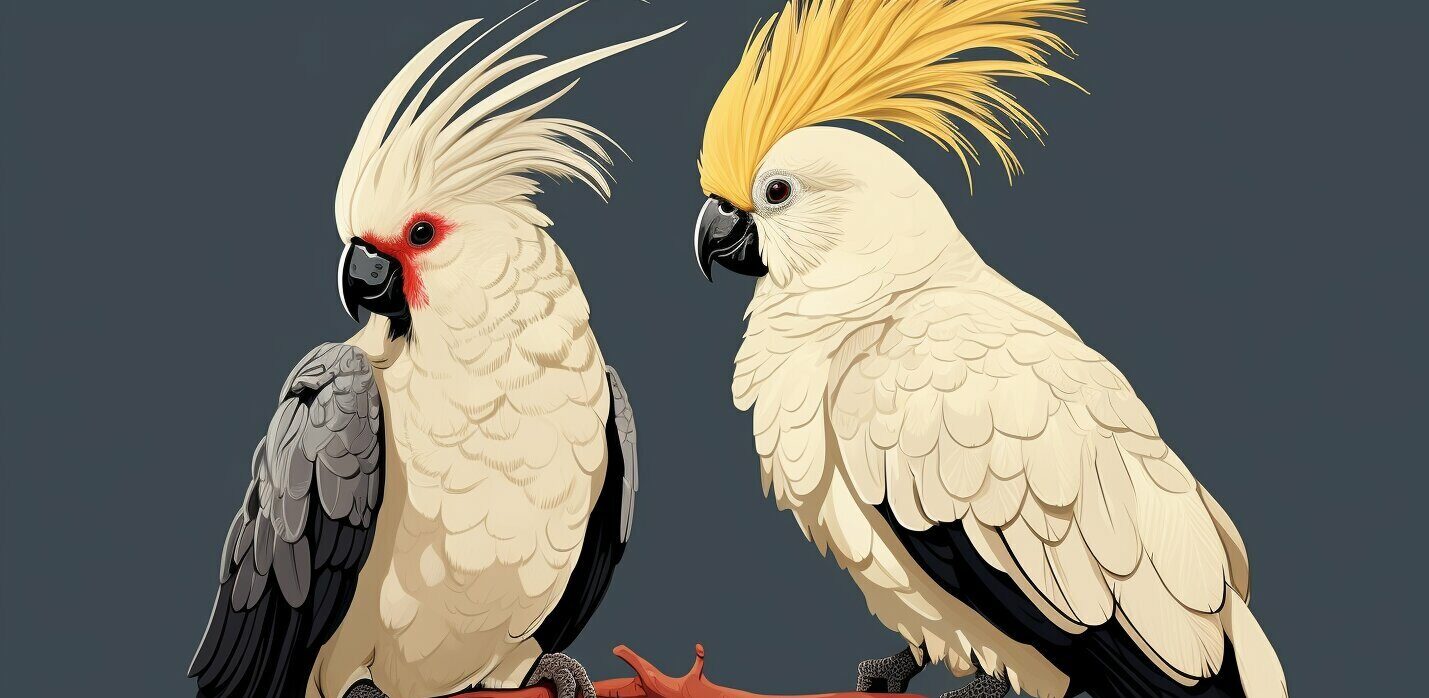Ptarmigans and grouse are often confused due to their similarities in appearance, but they belong to different sub-families within the grouse family, Tetraonidae. The grouse family includes both ptarmigans and other species such as pheasants, partridges, and prairie chickens.
Ptarmigans are characterized by their round, plump bodies and can be slimmer with longer necks compared to other grouse species. Within the grouse family, there are also sub-classifications called the grouse genus and the ptarmigan genus. The grouse genus includes species like ruffed, sage, and sharp-tailed grouse, while the ptarmigan genus includes the white-tailed, rock, and willow ptarmigan. Therefore, while ptarmigans are a part of the bigger grouse family, they are not included in the sub-classification of the grouse genus.
Grouse are found across the world and are known for their iconic status in Canada and the Arctic Circle. On the other hand, ptarmigans are partridge-like grouse that inhabit cold regions and undergo seasonal changes in plumage. They are well-adapted to survive the harsh conditions of the Arctic and mountain-top environments.
Ptarmigan species include the common ptarmigan or rock ptarmigan, willow ptarmigan, and white-tailed ptarmigan. The common ptarmigan is found in the British Isles, Europe, and North America, while the willow ptarmigan is more northerly and the white-tailed ptarmigan is found in the Rocky Mountains. Ptarmigans are distinguished from other grouse species by their feathered toes and their ability to change plumage color to blend into their surroundings.
- Ptarmigans and grouse belong to different sub-families within the grouse family, Tetraonidae.
- Ptarmigans are characterized by their round, plump bodies and can be slimmer with longer necks.
- Grouse are found across the world, while ptarmigans inhabit cold regions and undergo seasonal changes in plumage.
- Ptarmigan species include the common ptarmigan, willow ptarmigan, and white-tailed ptarmigan.
- Ptarmigans have feathered toes and the ability to change plumage color to blend into their surroundings.
Ptarmigan Characteristics
Ptarmigans are characterized by their round, plump bodies and their ability to change plumage color to blend into their surroundings. These unique features allow them to adapt and survive in their cold and harsh habitats, such as the Arctic and mountain-top environments. With their compact bodies, ptarmigans are well-equipped to withstand extreme temperatures and navigate through snowy terrains. Their short wings and feathered toes help them move smoothly on the ground and provide insulation against the cold.
One of the most fascinating aspects of ptarmigans is their ability to change the color of their feathers. This seasonal adaptation enables them to camouflage effectively in their surroundings and evade predators. During the winter months, ptarmigans display a white plumage that helps them blend into the snow-covered landscapes. As the seasons change, their feathers transition to mottled brown or gray to match the vegetation in their habitat. This remarkable camouflage not only provides them with protection but also allows them to remain unseen while foraging for food.
Furthermore, ptarmigans have specialized feathers on their feet, known as pectinations, which act like snowshoes. These feathered toes increase their surface area, allowing them to walk on top of the snow without sinking. This unique adaptation helps them access food sources during the winter when the ground is covered with deep snow.
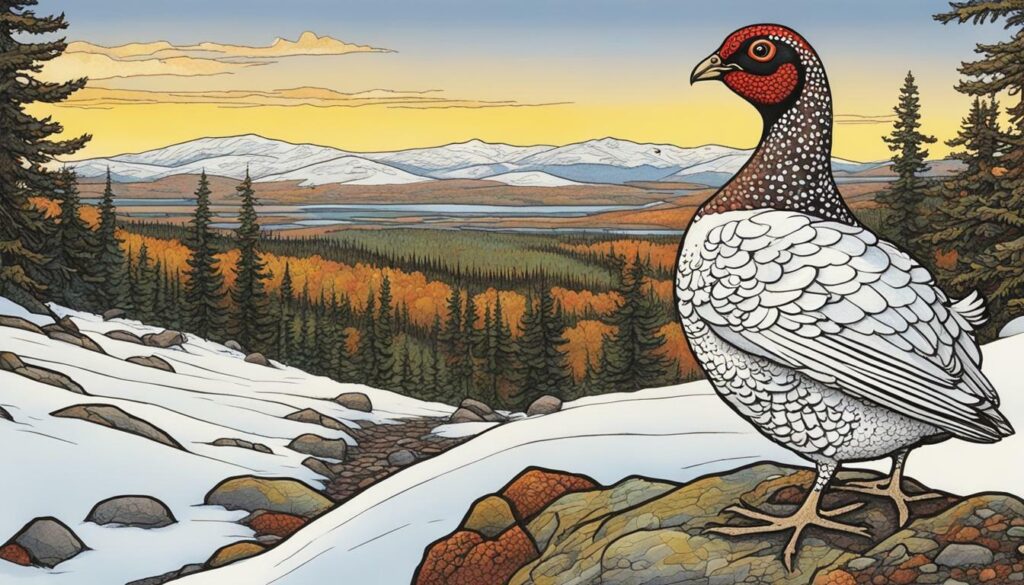
- Ptarmigans have round, plump bodies and can change plumage color to blend into their surroundings.
- Their compact bodies, short wings, and feathered toes make them well-adapted to cold environments.
- They display a white plumage in winter to camouflage in snowy landscapes and transition to mottled brown or gray in other seasons.
- Ptarmigans have specialized feathers on their feet that act as snowshoes, enabling them to walk on top of the snow.
| Ptarmigan Species | Habitat | Distribution |
|---|---|---|
| Common Ptarmigan | Mountains, tundra | British Isles, Europe, North America |
| Willow Ptarmigan | Tundra, boreal forests | Northern regions |
| White-tailed Ptarmigan | Alpine areas | Rocky Mountains |
Grouse Characteristics
Grouse, including ptarmigans, have certain shared characteristics, such as their round bodies and feathered toes. These features help them adapt to their natural habitats and survive in various environments. Grouse are medium-sized birds with plump bodies, short wings, and broad tails, enabling them to fly swiftly and navigate through dense vegetation. Their strong feet and sharp claws aid in gripping tree branches and perching securely.
One of the distinguishing features of grouse is their feathered toes, which provide insulation and traction in snowy and icy conditions. This adaptation allows them to walk easily on snow-covered grounds and prevents their feet from freezing. Additionally, grouse have strong, muscular legs that contribute to their agility and ability to take off quickly when threatened.
Grouse are ground-dwelling birds and are known for their camouflage abilities. Their plumage varies depending on the season to blend in with their surroundings, providing them with protective coloration. For example, in the winter, ptarmigans exhibit a white feathered coat, allowing them to remain hidden in snowy environments. As the seasons change, their plumage transitions to brown and gray tones, matching the vegetation during the spring and summer months.
Grouse Species and Distribution
The grouse family includes various species found around the world. Apart from ptarmigans, there are other notable species like the ruffed grouse, sage grouse, and sharp-tailed grouse. Each species has its own unique characteristics and adaptations that allow them to thrive in different habitats. For instance, the ruffed grouse is native to North America and is known for its mottled brown plumage and drumming behavior during the mating season.
The distribution of grouse species is vast, with populations found in North America, Europe, Asia, and other regions. Some species are localized to specific geographical areas, while others have a wider range. For example, the sage grouse is primarily found in the sagebrush habitats of North America, while the rock ptarmigan can be found in the Arctic regions of North America and Eurasia.
| Grouse Species | Distribution |
|---|---|
| Ruffed Grouse | North America |
| Sage Grouse | North America |
| Rock Ptarmigan | Arctic regions of North America and Eurasia |
| Sharp-tailed Grouse | North America, Eurasia |
Understanding the characteristics and habitats of grouse species, including ptarmigans, provides valuable insights into the diverse world of these remarkable birds. Each species has its own specific adaptations that enable them to survive and thrive in their respective environments. Whether it’s their round bodies, feathered toes, or ability to change plumage, grouse showcase nature’s ingenuity and resilience.
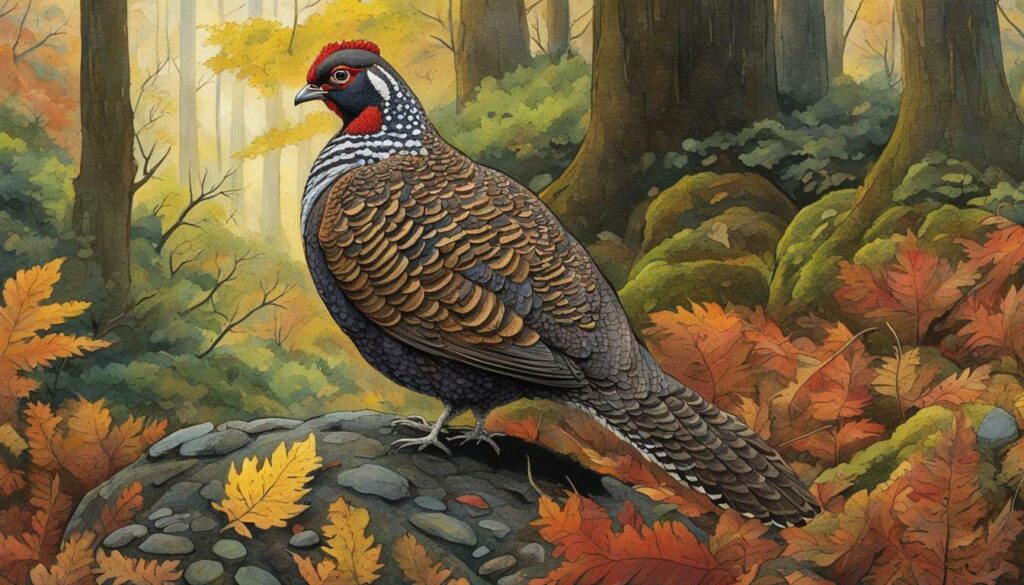
Ptarmigans are well-adapted to survive the harsh conditions of the Arctic and mountain-top environments, and their nesting behaviors are also noteworthy. These remarkable birds can be found in cold regions across the world, such as the British Isles, Europe, North America, and the Rocky Mountains. Their ability to thrive in such extreme environments is due to their unique physical and behavioral adaptations.
One of the key characteristics that sets ptarmigans apart is their feathered toes, which help them navigate through deep snow and icy terrain. This natural snowshoe-like feature enables them to walk effortlessly on powdery snow and prevents them from sinking, allowing them to access food sources even in the harshest winter conditions.
Their plumage color-changing ability also plays a vital role in their survival. Ptarmigans have the extraordinary ability to change the color of their feathers to blend into their surroundings. During the summer months, their plumage typically turns a mottled brown or gray to camouflage with the rocky terrain, while in winter, it transforms into a brilliant white to match the snowy landscape. This remarkable adaptation helps ptarmigans evade predators and increases their chances of survival.
In terms of nesting behavior, ptarmigans exhibit unique strategies. They create shallow depressions on the ground and line them with grass, twigs, and feathers to construct their nests. The female ptarmigan is the primary caretaker of the nest, incubating the eggs and protecting the young chicks. The nest location is carefully chosen to provide ample protection from predators and environmental elements.
| Ptarmigan Habitat and Behavior | |
|---|---|
| Physical Adaptations | Feathered toes, ability to change plumage color |
| Nesting Behavior | Construct nests on the ground lined with grass, twigs, and feathers |
| Habitat | Arctic and mountain-top environments |
Overall, ptarmigans are fascinating creatures that have evolved to thrive in the most challenging habitats. Their physical and behavioral adaptations allow them to not only survive but also flourish in the harsh conditions of the Arctic and mountain-top regions. By understanding their unique characteristics and behaviors, we gain a deeper appreciation for these extraordinary birds.
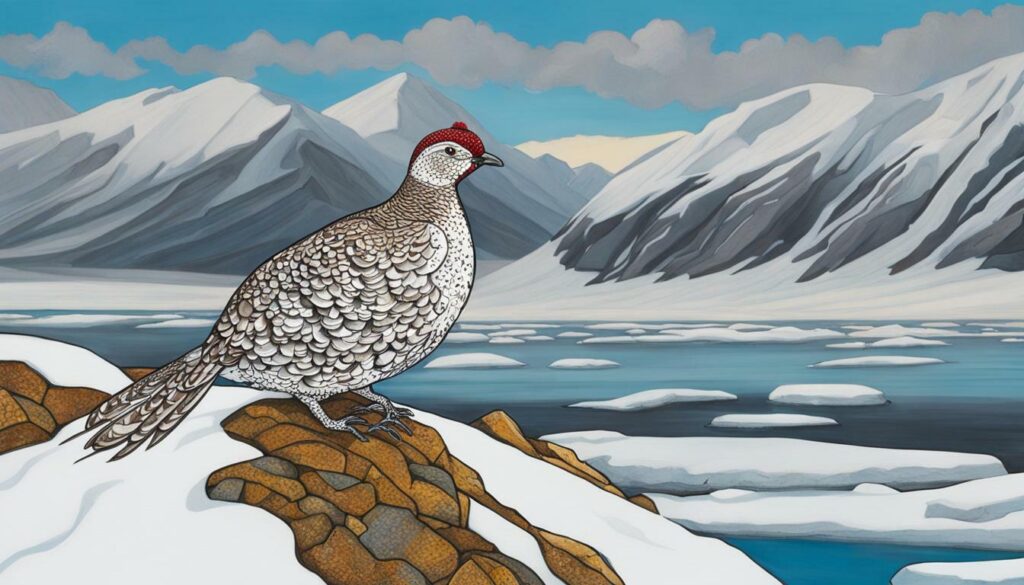
Grouse species, including ptarmigans, can be found across the world and exhibit a range of habitats and behaviors.
Grouse are known for their adaptability and can be found in various habitats, including forests, grasslands, and tundra. Some species, like the willow ptarmigan, are well-suited to cold environments and are often found in Arctic regions and mountainous areas. Other grouse species, such as the sage grouse, prefer drier habitats like sagebrush plains. These birds have evolved to thrive in their respective habitats, utilizing their camouflage and feeding on a diverse range of vegetation.
In terms of behavior, grouse are known for their elaborate courtship displays. Males will perform dances and fluff their plumage to attract females. These displays are often accompanied by distinctive vocalizations, such as drumming sounds created by rapidly beating their wings against their bodies. Grouse species also engage in territorial behaviors, defending their breeding grounds from intruders.
During the breeding season, grouse build nests on the ground or in low vegetation, creating shallow depressions lined with grass and feathers. Females typically lay a clutch of eggs, which they incubate for a period of several weeks. Once the chicks hatch, they are precocial, meaning they are relatively independent and able to feed themselves shortly after birth.
In conclusion, grouse species, including ptarmigans, are widely distributed and display a diverse range of habitats and behaviors. Understanding these characteristics can help us appreciate the unique adaptations and behaviors that make these birds so fascinating.
FAQ
Q: What is the difference between ptarmigans and grouse?
A: Ptarmigans and grouse are often confused due to their similarities in appearance. However, they belong to different sub-families within the grouse family, Tetraonidae. Grouse is a larger family that includes ptarmigans, pheasants, partridges, and prairie chickens. Ptarmigans have round, plump bodies and can be slimmer with longer necks compared to other grouse species.
Q: What are the characteristics of ptarmigans?
A: Ptarmigans are characterized by their round, plump bodies and their ability to undergo seasonal changes in plumage. They have feathered toes and the ability to change their plumage color to blend into their surroundings. Ptarmigans are well-adapted to survive in cold regions and are often found in the Arctic and mountain-top environments.
Q: What are the characteristics of grouse?
A: Grouse species, including ptarmigans, are characterized by their body structure and appearance. They have round, plump bodies and are known for their iconic status in Canada and the Arctic Circle. Grouse species differ in their plumage color and patterns, with some exhibiting more elaborate displays during mating season.
Q: Where do ptarmigans live and how do they behave?
A: Ptarmigans are primarily found in cold regions, such as the Arctic and mountain-top environments. They are well-adapted to survive harsh conditions and have unique nesting behaviors. Ptarmigans build their nests on the ground and females often blend into their surroundings by changing their plumage color. They are also known for their ability to camouflage and remain motionless to avoid detection by predators.
Q: Where do other grouse species live and how do they behave?
A: Grouse species other than ptarmigans have diverse distribution patterns. They can be found across the world, including North America, Europe, and Asia. Grouse species exhibit a range of behaviors, including elaborate courtship displays, territorial behavior, and seasonal movements. Some species, like the sage grouse, are known for their impressive mating rituals.
 Skip to main content
Skip to main content